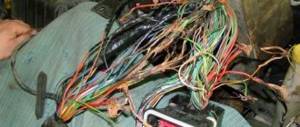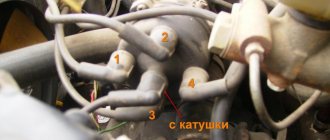Stabilizer selection
In the on-board network of the car, the operating power is approximately 13 V, while most LEDs are suitable for 12 V. Therefore, they usually install a voltage stabilizer, the output of which is 12 V. Thus, normal conditions are provided for the operation of lighting equipment without emergency situations and premature failure.
At this stage, amateurs are faced with the problem of choice: many designs have been published, but not all work well. You need to choose one that is worthy of your favorite vehicle and, in addition:
- will actually work;
- will ensure the safety and security of lighting equipment.
Circuits of stabilizers and current regulators
There are at least four options for making 12-volt voltage stabilizers for cars with your own hands:
- On a roll.
- On a pair of transistors.
- On an operational amplifier.
- On a pulse stabilizer chip.
Let's look at the main features of each of the modifications under consideration.
On a roll
To assemble a simple stabilizer for 12-volt LEDs for a car with your own hands, you will need:
- Microcircuit LM317 or KREN8B (more precisely KR142EN8B), or KIA7812A.
- 120 ohm resistor.
- Printed board or perforated panel.
The simplest DIY voltage stabilizer
If you have no desire to buy a ready-made device, then it’s worth learning how to make a simple stabilizer yourself. It is difficult to make a pulse stabilizer in a car with your own hands. That is why it is worth taking a closer look at the selection of amateur circuits and designs of linear voltage stabilizers. The simplest and most common version of a stabilizer consists of a ready-made microcircuit and a resistor (resistance).
The easiest way to make a current stabilizer for LEDs with your own hands is on the LM317 chip. The assembly of parts (see figure below) is carried out on a perforated panel or a universal printed circuit board.
The device allows you to maintain a uniform glow and completely eliminate the blinking of light bulbs.
Scheme of a 5 ampere power supply with a voltage regulator from 1.5 to 12 V.
To assemble such a device yourself, you will need the following parts:
- plateau size 35*20 mm;
- chip LD1084;
- RS407 diode bridge or any small diode for reverse current;
- a power supply consisting of a transistor and two resistances. Designed to turn off the rings when the high or low beam is turned on.
In this case, the LEDs (3 pcs.) are connected in series with a current-limiting resistor that equalizes the current. This set, in turn, is connected in parallel to the next similar set of LEDs.
DIY crafts for car enthusiasts
So, why do marker bulbs, LED bulbs or other LED bulbs that are in the car burn out so quickly, because they use a regular current-limiting resistor as a driver.
As a rule, LED lighting devices with a power of 10 W and above already use a high-quality pulse stabilizer - the driver does not suffer from such a disease, unlike large, cheap LED lamps.
First, these light bulbs begin to flicker, that is, these are already the first signs of crystal degradation, and then they simply burn out. On average, a simple LED light bulb has a lifespan of one year, sometimes less, sometimes a little more.
Why is this happening?
And this happens because this current-limiting resistor is calculated using a specialized formula (there are many such calculators online on the Internet) and is connected to the appropriate voltage.
And here the manufacturer does a very clever thing: on some sockets it says 12 volts, that is, the current-limiting resistor for this light bulb is designed for 12 volts. And in a car circuit, as we know, the voltage is not only 12 volts, but also reaches 14.5 volts. That is, from this we conclude that an LED light bulb at 12 volts is already operating at maximum power, and already more than 12 volts there is severe wear on the LED crystal, in a word, severe overload.
So, how can we make sure that they don’t burn out? I, too, was tired of changing them at one time, so I decided to study this issue thoroughly and make a converter in which the LED light bulb became almost eternal.
Of course, there are converters on Ali Express that are already designed for these purposes,
but there is one BUT... they produce high-frequency pulse noise, but this is inherent in all switching power supplies. This gives a lot of interference, for example, when using FM modulators, especially when listening to the radio, and even just interference into the speaker system. From this point of view, you should try to fill your car with switching power supplies as little as possible.
Therefore, we will make a linear stabilizer with a fixed voltage, which has great advantages. The first advantage is that it costs mere pennies compared to impulse ones. Secondly , the stabilizer is linear and does not produce any interference or high-frequency interference at all.
For this we need the L7812cv stabilizer itself,
It will be designed for 1.5 Amperes and a pair of 100 n capacitors.
The circuit itself is quite simple, I would even say very simple, and any car enthusiast can assemble it.
The left leg is a positive input (from 12 to 30 volts), and the right leg is a stable positive 12-volt output. General minus. That is, the stabilizer can be connected to the gap in the positive wire that goes to the light bulb or DRL.
The two capacitors that are in the circuit are a kind of filter; if you have never done this, then you can neglect them, that is, simply not install them.
Here is a ready-made version of how I did it.
I soldered everything on the board and put it in heat shrink so that nothing would short out anywhere, the result was an almost eternal design.
I had leftover blanks from printed circuit boards, and I assembled them from this waste.
Yes.., I attached the stabilizer itself to the board via thermal tape. If you don’t have thermal tape, I advise you to place the stabilizer on a radiator so that it does not overheat, it’s more reliable. This is the thermal tape I used:
a very good and useful thing, so as not to bother with all sorts of thermal pastes and so on. For those who want to purchase, here is the link https://ali.pub/27tn5c.
—I also give a link to the stabilizer itself https://ali.pub/27tmdj —And contact blocks https://ali.pub/27tnev.
Accordingly, you can do the installation as you wish, on a breadboard or mounted, the quality of the stabilizer will not suffer from this.
You did it once, installed it, and now you won’t have any problems with burnt out or flickering LED lamps. All the best.
Popular;
- Why is the LED in the car blinking and what should I do?
- Making an LED lamp with your own hands
- The simplest voltage stabilizer for DRLs based on L7812
- Voltage stabilizer for a car
- Voltage converter from 12 to 220 volts from the xenon ignition unit.
- Simple stabilizer for wall-mounted LEDs
- How to easily make car lamps brighter.
- How to make a simple converter from 12 to 220 from a computer power supply
Stabilizer for LEDs on the L7812 chip in cars
The current stabilizer for LEDs can be assembled on the basis of a 3-pin DC voltage regulator (L7812 series). The mounted device is perfect for powering both LED strips and individual light bulbs in a car.
Required components to assemble such a circuit:
- chip L7812;
- capacitor 330 uF 16 V;
- capacitor 100 uF 16 V;
- 1 ampere rectifier diode (1N4001, for example, or a similar Schottky diode);
- wires;
- heat shrink 3 mm.
There can actually be many options.
Selection of 12 V stabilizer
The car's on-board network provides power from 13 V, but LEDs need only 12 V to operate. That is why it is necessary to install a voltage stabilizer, which will provide exactly 12 V at the output.
By installing such equipment, it will ensure normal conditions for the operation of LED lighting, which will not fail for a long time. When choosing stabilizers, motorists are faced with problems, since there are so many designs, and they all work differently.
You should select a stabilizer that:
- It will function correctly.
- Provides reliable protection and safety of lighting equipment.
Connection diagram based on LM2940CT-12.0
The stabilizer body can be made of almost any material except wood. When using more than ten LEDs, it is recommended to attach an aluminum radiator to the stabilizer.
Maybe someone has tried it and will say that you can easily do without unnecessary troubles by directly connecting the LEDs. But in this case, the latter will be in unfavorable conditions most of the time, and therefore will not last long or will burn out altogether. But tuning expensive cars results in a fairly large sum.
As for the described schemes, their main advantage is simplicity. Manufacturing does not require any special skills or abilities. However, if the circuit is too complex, then assembling it with your own hands becomes unreasonable.
How to make a 12-volt voltage stabilizer for LEDs in a car using the L7812 chip
To assemble a high-quality voltage stabilizer, you can use a three-pin DC voltage regulator, available in the L7812 series. This device will power not only individual light bulbs in a car, but also an entire strip of LEDs.
L7812
Components:
- Chip L7812.
- Capacitor 330 uF 16 V.
- Capacitor 100 uF 16 V.
- 1 amp rectifier diode. You can use a 1n4001 or a Schottky diode.
- Heat shrink 3 mm.
- Connecting wires.
Assembly order:
- We slightly shorten one leg of the stabilizer.
- We use solder.
- We add a diode to the short leg, and then capacitors.
- We place heat shrink on the wires.
- We are soldering wires.
- We put on the heat shrink and press it with a hair dryer or a lighter. It is important not to overdo it and not melt the heat shrink.
- We supply power to the input on the left side, and on the right there will be an output to the LED strip.
- We carry out a test - turn on the lighting. The tape should light up, its service life will now increase.
This is how you make a 12V voltage stabilizer with your own hands.
Stabilizer for LEDs
The easiest way to make a current stabilizer for LEDs with your own hands is using LM317; you just need to calculate the resistor for the LED using an online calculator. Food can be used at hand, for example:
- laptop power supply 19V;
- from the printer at 24V and 32V;
- from consumer electronics at 12 volts, 9V.
The advantages of such a converter are low price, easy to buy, minimum parts, high reliability. If the current stabilizer circuit is more complex, then assembling it with your own hands becomes irrational. If you are not a radio amateur, then a pulse current stabilizer is easier and faster to buy. In the future, it can be modified to the required parameters. You can find out more in the “Ready-made modules” section.
Purpose of a voltage stabilizer
LEDs cannot be connected directly to the vehicle's electrical network. You need to use drivers for them. They protect against current surges in the electrical network, overheating, and component failure.
For LEDs, a voltage of 12 V is sufficient, so the stabilizers are assembled in such a way that the output has exactly this value. As a result, everything works stably and does not fail.
There are several circuits and designs of 12 Volt voltage regulators with your own hands. You should choose one that will suit your vehicle and ensure safe operation.
Simple DIY CH
Parametric voltage stabilizer
A 12-volt voltage stabilizer for LEDs, backlights of automotive on-board systems is quickly and conveniently performed using microcircuits: LM317, LD1084, L7812, KREN 8B and similar devices. Several diodes, a resistance and the microcircuit itself are the components of such a circuit.
Stabilizer on LM317
Depending on the manufacturing option of the LM317 case, the arrangement of parts on the board is selected.
LM317 with heatsink mount
Making a stabilizer comes down to the following:
- a resistance with a nominal value of 130 Ohms is soldered to the output (Vout);
- a wire supplying voltage for stabilization is connected to the input contact (Vin);
- the adjustment input (Adj) is connected to the second terminal of the resistor.
When connecting LED lights, strips, etc. as a load. no radiator required. Assembly takes 15-20 minutes with a minimum of parts. Using a simple formula, you can calculate the value of resistance R to obtain a certain value of the permissible load current.
CH circuit on LM317
Circuit on the LD1084 chip
The use of this microassembly will help maintain the 12 V voltage constant for LED illumination devices connected to the vehicle’s on-board network.
Datasheet LD1084
Here, to assemble a homemade CH, the following is included in the circuit binding circuit of the microcircuit:
- two electrolytic capacitors of 10 μF * 25 V;
- resistors: 1 kOhm (2 pcs.), 120 Ohm, 4.7 kOhm (can be constant);
- diode bridge RS407.
The device is assembled as follows:
- the voltage removed from the rectifier diode bridge is supplied to the input of LD1084;
- the emitter of the KT818 transistor is connected to the contact that controls the stabilization mode (Adj), the base of which is connected through two single-column resistors to the power supply circuits for the headlights (low and high);
- the output circuit of the microcircuit is connected to resistors R1 and R2, as well as a capacitor.
By the way. Resistor R2 can be taken not as a variable, but as a tuning one, using it to set the output voltage to 12 V.
SN for on-board network
Stabilizer on diodes and assembly L7812
A similar microcircuit in conjunction with a diode and capacitors can supply LEDs with a stable voltage of 12 V.
The scheme is built according to the principle outlined below:
- The 1N401 Schottky diode passes current from the positive terminal of the battery through itself and supplies it to the input of the microcircuit. In this case, the “+” of the electrolyte (330 μF capacitor) is also connected to the cathode of the diode;
- a load circuit and a “+” capacitor with a capacity of 100 μF are connected to the output of L7812;
- all negative terminals (from the battery and both electrolytic capacitors) are connected to the control input of the microcircuit.
Electrolytic capacitors are selected for a voltage of at least 25 V.
12 V stabilizer circuit on IC L7812
The simplest stabilizer is the KREN board
Schemes using rolls are quite popular. This is the name for ICs whose markings include combinations of the letters KR and EN. These are powerful SNs that allow you to supply a current of up to 1.5 A to the load. They have a stable 12 V output when a voltage of up to 35 V is applied to the input.
The circuit using this microcircuit is assembled like this:
- voltage from the positive terminal of the battery (rechargeable battery) to the bank input is supplied through a 1N4007 diode, it protects the battery circuit from reverse voltages;
- the negative terminal of the battery is connected to the control electrode KREN;
- The output voltage is supplied to the load.
If necessary, the microcircuit is screwed to the radiator.
KR142EN8B, connection diagram
Assembling 12 V voltage stabilizers with your own hands using linear and integrated MV circuits is not difficult. In this case, it is necessary to monitor the heating temperature of the housing of the elements and, when T0C is higher than permissible, install them on heat sinks (radiators).
Voltage stabilizer for LEDs
There are several options for making a stabilizer for car LEDs with your own hands. You can choose methods with easy assembly, with available spare parts, or the most reliable ones.
The ideal option is that you didn’t spend a lot of time, but the device works for many years.
WATCH THE VIDEO
Assembling a powerful integrated regulator
To make a 12 Volt voltage stabilizer with your own hands, you will need:
- Capacitors 330 µF and 100 µF 16 V;
- Chip L7812;
- Schottky diode;
- Heat shrink and wires.
- Google+
- LJ
- Blogger
Stages of work:
- Shorten one output of the regulator and solder a diode and capacitors to it.
- Solder the wires with heat shrink on them. After the diode, connect the wire to the power positive.
- Connect another output to the LED strip.
- Connect the central output to the power supply minus. Also connect the LED strip to the negative wire of the power supply.
Scheme of an adjustable stabilizer using transistors
This circuit allows you to make an adjustable 12 Volt stabilizer. It is rated for 1 Ampere current. Current protection is provided on transistor VT3. It opens if the current exceeds 1.2 Amperes.
If your current is more than 1 Ampere, you can modify the circuit by replacing transistors VT1 and VT2 with more powerful ones.
- Google+
- LJ
- Blogger
Switching regulator
Stabilization is carried out by alternating pulses and pauses. These devices are more reliable than linear ones. They can convert voltage according to predetermined parameters. The switching stabilizer for 12 Volt LEDs can be step-down or step-up. This regulation occurs through different schemes. It is installed not only on LEDs, but also on other electrical appliances in the car.











